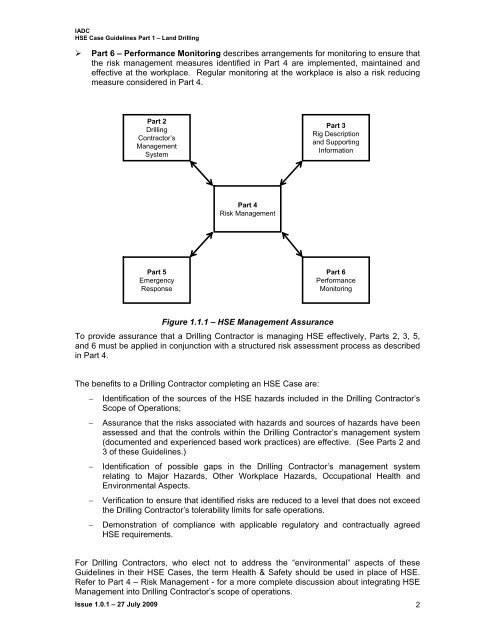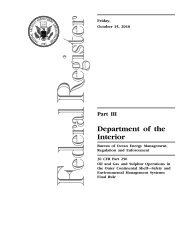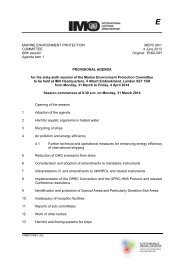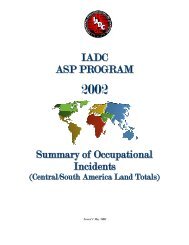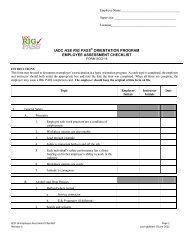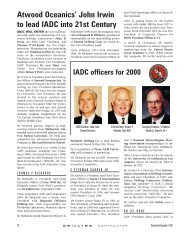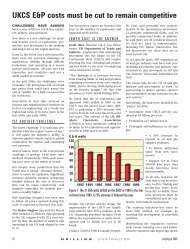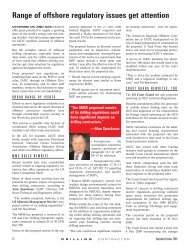IADC HSE Case Guidelines for Land Drilling Units - Issue 1.0.1
IADC HSE Case Guidelines for Land Drilling Units - Issue 1.0.1
IADC HSE Case Guidelines for Land Drilling Units - Issue 1.0.1
Create successful ePaper yourself
Turn your PDF publications into a flip-book with our unique Google optimized e-Paper software.
<strong>IADC</strong><br />
<strong>HSE</strong> <strong>Case</strong> <strong>Guidelines</strong> Part 1 – <strong>Land</strong> <strong>Drilling</strong><br />
‣ Part 6 – Per<strong>for</strong>mance Monitoring describes arrangements <strong>for</strong> monitoring to ensure that<br />
the risk management measures identified in Part 4 are implemented, maintained and<br />
effective at the workplace. Regular monitoring at the workplace is also a risk reducing<br />
measure considered in Part 4.<br />
Part 2<br />
<strong>Drilling</strong><br />
Contractor’s<br />
Management<br />
System<br />
Part 3<br />
Rig Description<br />
and Supporting<br />
In<strong>for</strong>mation<br />
Part 4<br />
Risk Management<br />
Part 5<br />
Emergency<br />
Response<br />
Part 6<br />
Per<strong>for</strong>mance<br />
Monitoring<br />
Figure 1.1.1 – <strong>HSE</strong> Management Assurance<br />
To provide assurance that a <strong>Drilling</strong> Contractor is managing <strong>HSE</strong> effectively, Parts 2, 3, 5,<br />
and 6 must be applied in conjunction with a structured risk assessment process as described<br />
in Part 4.<br />
The benefits to a <strong>Drilling</strong> Contractor completing an <strong>HSE</strong> <strong>Case</strong> are:<br />
Identification of the sources of the <strong>HSE</strong> hazards included in the <strong>Drilling</strong> Contractor’s<br />
Scope of Operations;<br />
Assurance that the risks associated with hazards and sources of hazards have been<br />
assessed and that the controls within the <strong>Drilling</strong> Contractor’s management system<br />
(documented and experienced based work practices) are effective. (See Parts 2 and<br />
3 of these <strong>Guidelines</strong>.)<br />
Identification of possible gaps in the <strong>Drilling</strong> Contractor’s management system<br />
relating to Major Hazards, Other Workplace Hazards, Occupational Health and<br />
Environmental Aspects.<br />
Verification to ensure that identified risks are reduced to a level that does not exceed<br />
the <strong>Drilling</strong> Contractor’s tolerability limits <strong>for</strong> safe operations.<br />
Demonstration of compliance with applicable regulatory and contractually agreed<br />
<strong>HSE</strong> requirements.<br />
For <strong>Drilling</strong> Contractors, who elect not to address the “environmental” aspects of these<br />
<strong>Guidelines</strong> in their <strong>HSE</strong> <strong>Case</strong>s, the term Health & Safety should be used in place of <strong>HSE</strong>.<br />
Refer to Part 4 – Risk Management - <strong>for</strong> a more complete discussion about integrating <strong>HSE</strong><br />
Management into <strong>Drilling</strong> Contractor’s scope of operations.<br />
<strong>Issue</strong> <strong>1.0.1</strong> – 27 July 2009 2


